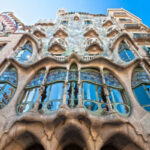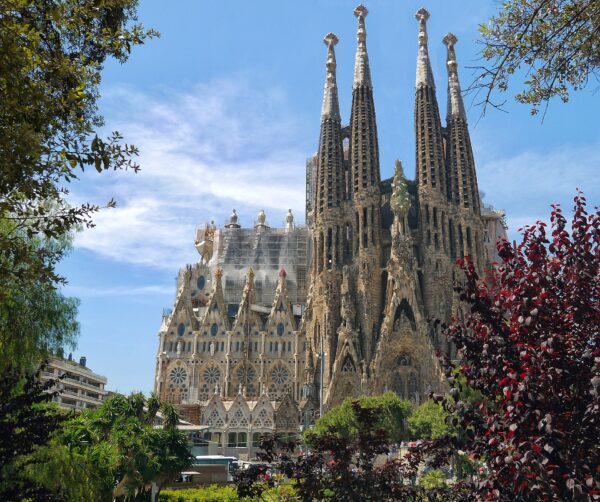
- The Architectural Marvel of Sagrada Familia: A Detailed Overview
- Understanding the Symbolism Behind Sagrada Familia's Design
- The Construction Timeline of Sagrada Familia: A Journey Through Time
- Exploring Gaudí's Vision: The Artistic Influence on Sagrada Familia
- Sagrada Familia: A UNESCO World Heritage Site and Its Global Significance
- Visiting Sagrada Familia: Tips for an Enriching Experience
The Sagrada Familia, an iconic masterpiece designed by architect Antoni Gaudí, is more than just a basilica; it is a symbol of Barcelona's artistic and cultural heritage. Its construction began in 1882, and since then, it has captivated millions with its intricate facades and towering spires, embodying the spirit of Modernisme in every detail.
Exploring The Enigmatic History of Sagrada Familia in Barcelona reveals a tale of ambition, creativity, and perseverance. With its ongoing construction, which is expected to conclude in the coming years, this architectural wonder continues to evolve, representing a unique blend of tradition and innovation that reflects the city’s dynamic character.
The Architectural Marvel of Sagrada Familia: A Detailed Overview
The Sagrada Familia stands as an architectural marvel that fuses natural forms with religious symbolism, drawing inspiration from the organic shapes found in nature. Gaudí's innovative use of geometry and light is evident in features such as the hyperboloid structures and intricate stained glass windows, which bathe the interior in a vibrant spectrum of colors. This attention to detail makes every visit a unique experience, inviting contemplation and awe.
One of the most distinctive aspects of Sagrada Familia's design is its three grand facades: the Nativity, Passion, and Glory. Each facade tells a different story from the life of Christ and showcases a variety of sculptural styles that range from Gothic to Art Nouveau. The fusion of these styles not only reflects Gaudí's genius but also embodies the spiritual journey that the basilica aims to represent.
In terms of structural innovation, the Sagrada Familia incorporates advanced techniques that were ahead of Gaudí's time. Notable features include:
- Tree-like columns that support the roof, mimicking natural growth
- Complex geometrical shapes that enhance stability and aesthetic appeal
- A unique system of vaults that distributes weight efficiently
These elements contribute to its resilience and ensure that the basilica can withstand the test of time while remaining a beacon of architectural brilliance.
The ongoing construction of Sagrada Familia continues to reflect Gaudí's vision, with the completion of the basilica projected for 2026, marking the centenary of his death. Each phase of construction is meticulously planned to adhere to Gaudí's original designs while incorporating modern technologies. As such, the Sagrada Familia is not only a testament to the past but also a living example of architectural evolution in contemporary society.
Understanding the Symbolism Behind Sagrada Familia's Design
Understanding the symbolism behind the design of Sagrada Familia unveils a deep connection between architecture and spirituality. Antoni Gaudí infused the basilica with elements that reflect Christian beliefs, which are manifested in various features. These include the incorporation of natural forms that signify the divine presence, as well as the use of light to symbolize the connection between heaven and earth.
Each facade of Sagrada Familia conveys significant narratives, serving as a visual catechism for visitors. For instance, the Nativity facade depicts the birth of Christ with intricate carvings that highlight themes of renewal and innocence. Conversely, the Passion facade starkly illustrates the suffering and sacrifice of Jesus, presenting an emotional contrast that enriches the overall experience of the basilica.
Moreover, the interior space is designed to evoke a sense of awe and contemplation. The use of columnar trees not only supports the structure but also creates an immersive environment that resembles a forest, inviting visitors to feel a sense of peace and connection with nature. This design choice aligns with Gaudí's philosophy of integrating architecture with the natural world, emphasizing the sacredness of creation.
In addition to its religious significance, Sagrada Familia also embodies cultural symbolism unique to Barcelona. Its design reflects the city's Modernisme movement, showcasing a blend of artistry and craftsmanship that leaves a lasting impression on all who encounter it. Through its complex symbolism, the Sagrada Familia stands as a testament to the power of faith and creativity.
The Construction Timeline of Sagrada Familia: A Journey Through Time
The construction timeline of Sagrada Familia is a fascinating journey that intertwines history and architectural ambition. Starting in 1882, the project faced numerous challenges, from funding shortages to the impact of the Spanish Civil War. Despite these obstacles, the basilica has gradually progressed, embodying the perseverance of its builders and the vision of Antoni Gaudí.
Key milestones in the construction timeline include:
- 1882: Initial construction begins under architect Francisco de Paula del Villar.
- 1883: Antoni Gaudí takes over the project, radically changing its design.
- 1926: Gaudí's death halts progress, leaving many parts of the building incomplete.
- 2026: Expected completion date, coinciding with the centenary of Gaudí's passing.
The construction of Sagrada Familia is characterized by its evolving techniques and materials. Over the years, advancements such as:
- 3D modeling for precise architectural planning
- New materials that mimic Gaudí's original designs
- Innovative construction methods that speed up the building process
have been employed, ensuring that the basilica not only honors Gaudí's vision but also embraces modern engineering practices.
Additionally, the ongoing work reflects a unique collaboration between traditional craftsmanship and contemporary technology. This synthesis is evident in the intricate details of the facades and interiors, which continue to captivate visitors. As Sagrada Familia nears completion, it stands as a testament to the enduring spirit of creativity and the architectural evolution of Barcelona.
Exploring Gaudí's Vision: The Artistic Influence on Sagrada Familia
Exploring Gaudí's vision reveals a profound artistic influence that permeates the Sagrada Familia, transforming it into a vibrant narrative of creativity. Gaudí's approach was deeply rooted in nature, drawing inspiration from organic forms and structures. This connection to the natural world is evident in the basilica's undulating lines and intricate details, which mimic the growth patterns found in trees and flowers, establishing a harmonious relationship between architecture and the environment.
Furthermore, Gaudí's innovative use of light serves as a fundamental aspect of his artistic vision. The way sunlight filters through the stained glass creates a kaleidoscope of colors within the interior, enhancing the spiritual atmosphere of the space. This intentional manipulation of light not only illuminates the basilica but also symbolizes the divine presence, encouraging visitors to reflect on their own spiritual journeys as they navigate through this architectural masterpiece.
The collaboration of various artistic styles in Sagrada Familia showcases Gaudí's unique ability to blend elements of Gothic, Art Nouveau, and even ancient Roman influences. Each facade and detail is deliberately designed to contribute to a cohesive narrative, inviting viewers to experience a sense of wonder. By merging these diverse influences, Gaudí not only celebrates the history of architecture but also sets the stage for future generations to appreciate the richness of artistic expression.
In summary, Gaudí's vision for the Sagrada Familia extends beyond mere construction; it embodies a philosophical exploration of art, nature, and spirituality. The basilica stands as a testament to his genius, reflecting his desire to create a space that resonates with both the divine and the natural world. As visitors immerse themselves in this extraordinary environment, they become part of a living narrative that continues to evolve with each phase of construction.
Sagrada Familia: A UNESCO World Heritage Site and Its Global Significance
Recognized as a UNESCO World Heritage Site, the Sagrada Familia is not only an architectural gem but also a cultural symbol that resonates globally. Its designation highlights the basilica's exceptional artistic value and its embodiment of the Modernisme movement. As a UNESCO site, it attracts millions of visitors yearly, fostering a greater appreciation for architectural heritage and inspiring conservation efforts worldwide.
The significance of the Sagrada Familia extends beyond its stunning design; it represents a fusion of spirituality and creativity that resonates with diverse audiences. This landmark serves as a pilgrimage site for many, inviting exploration of personal faith while simultaneously acting as a canvas for artistic innovation. The ongoing construction project exemplifies a commitment to preserving Gaudí's vision while embracing contemporary methods, further enhancing its global appeal.
Moreover, the Sagrada Familia stands as a testament to the power of collaboration in the architectural realm. The involvement of skilled artisans, engineers, and architects from around the world exemplifies a shared dedication to craftsmanship and cultural exchange. This synergy not only enriches the construction process but also amplifies the basilica's significance as a symbol of unity and shared human experience.
In conclusion, the Sagrada Familia is more than a remarkable building; it is a cultural beacon that highlights the importance of preserving architectural heritage. Its status as a UNESCO World Heritage Site underscores the need to celebrate and protect such masterpieces, ensuring that future generations can experience the profound beauty and significance of this iconic structure.
Visiting Sagrada Familia: Tips for an Enriching Experience
When planning your visit to the Sagrada Familia, consider purchasing your tickets online in advance to avoid long queues. This allows you to maximize your time exploring Gaudí's masterpiece rather than waiting in line. Additionally, visiting during off-peak hours, such as early in the morning or late in the afternoon, can provide a more tranquil experience, enabling you to appreciate the intricate details of the basilica.
Before your visit, familiarize yourself with the different aspects of Sagrada Familia's design. Understanding the significance of the three grand facades—the Nativity, Passion, and Glory—will enrich your experience. You may also want to consider joining a guided tour, which can offer insights into the architectural innovations and spiritual symbolism that define this remarkable building.
As you explore the interior, take your time to observe the play of light through the stained glass windows. Each color and pattern tells a story, enhancing the sense of awe within the cathedral. Don’t forget to bring a camera, as the unique architectural features and stunning views from the towers present countless photo opportunities that capture the essence of Gaudí's vision.
Lastly, be respectful of the sacred nature of the space during your visit. Remember that Sagrada Familia is a functioning basilica, and maintaining a quiet demeanor allows everyone to appreciate its beauty. Take a moment for personal reflection or prayer, connecting with the spiritual atmosphere that makes this site truly special.
 Gaudí's Colorful Masterpiece in Barcelona
Gaudí's Colorful Masterpiece in Barcelona The Sagrada Familia: Unveiling the Architectural Marvel
The Sagrada Familia: Unveiling the Architectural MarvelIf you want to know other articles similar to The Enigmatic History of Sagrada Familia in Barcelona you can visit the category WHERE YOU CAN GO.
Deja una respuesta










Read more!